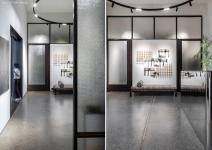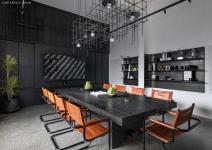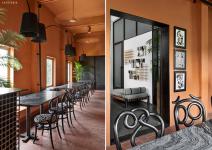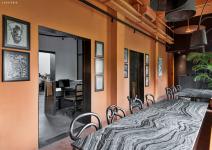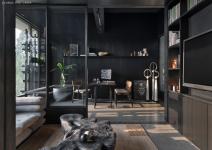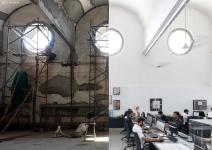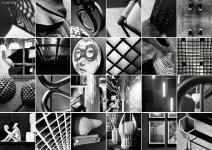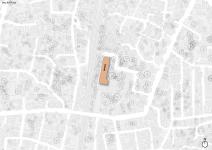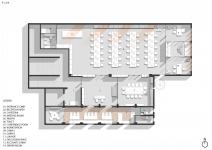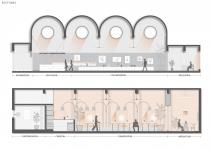THE ADND SILO
Establishing its latest design headquarters in the vibrant heart of Bombay, ADND embarks on its newest chapter amidst a historically rich time and place. The atelier's office embraces a redefined syntax of raw materiality and bold architectural nuances, heralding a long-awaited beginning.
Marking its 22nd year into its design sojourn, the twin-founder studio, ADND, inhabits a home that heralds a new advent in myriad ways. The creative union between Principal Architects Anand Menon and Shobhan Kothari is emblematic of a fateful collision of worlds. Menon, an art aficionado and Kothari, a lexophile, have relentlessly nurtured the ADND dream over two decades, laced with banter, grit, and a voracious appetite to build a legacy that would earnestly outlive them.
What ensued was a tryst with destiny. The city’s map was splayed. An engaging (seemingly unending) real estate-sifting quest began months before gold was struck! In the heart of Mumbai’s Vile Parle, awaiting the flick of a design wand rested a 100-year-old industrial compound inhabited formerly by the prestigious heritage enterprise of Parle, a household name in the Indian subcontinent. Decrepit, mould-ridden, and embodying dilapidation with its crackled floors, the site was roosted on the third floor of the premises. It functioned as a light-devoid stockpile house for the erstwhile tenants.
Raw, gritty, and inherently endowed with architectural character, this silo building was rough around the edges but held untapped promise brewing under its skin and the stars aligned when Anand and Shobhan caught a glimpse of magic waiting to be unearthed and moulded into being! Hugging the railway lines along its western edge, the building’s interiors harness an interplay of morphing internal heights and hold a picture window into the bustle of the city with the hissing and rumbling of whizzing trains as the eternal background score.
ADND’s design intent was explicitly clear — to delve into this holistic, adaptive reuse endeavour with a keen eye on bold architectural nuances and utilise materials as a medium to convey what evolved luxury can resemble in the current Indian design landscape. The unfinished canvas, askew walls, elongated girders, and chunky bolts were seen as remnants of the past debuting in the space, akin to an inheritance passed down among the hands of successive generations. The shell holds within a symphony of terrazzo-embedded concrete floors cast in situ, met by textured walls, colossal metal-frame doors, and isolated pools of colour gracing the office in coy doses.
The dapper, dark lift lobby gives way to the gallery-esque reception, bearing a modernist yet timeless purity. The room’s almost sacrosanct demeanour is encountered as one walks through the black metal door frames infilled with frosted, wired glass, a forgotten leitmotif of design through the 80s and 90s.
One’s vision meets the charpoy-style baithak (informal seating) conceptualised against the focal wall bearing Artist Rathin Burman’s installation, a mishmash of elements that find their roots in architectural descent. A chrome-finished desk deliberately dissolves into the sea of concrete below, posing as a mirage, present yet virtually invisible. Kothari’s endearment for the written word is echoed through the blueprint, phrases and maxims capriciously sown into spaces. The word ‘perception’ sits embedded in the floors, mirrored in the reflective, molten-chrome desk’s fascia.
Oozing terracotta, the studio café resembles a vibrant Moroccan bistro that belies the petite square footage of the 11-foot-wide rectilinear space. The floors, walls, and benches savour the earthen hue, albeit as a smorgasbord of materiality ranging from paint, micro-concrete, and clay pavers that will gradually garner a rustic patina.
A monochrome, veiny river of marble streams through the café’s centre, manifesting as the Indian black marble tabletops. The bespoke dichromatic art and the contorted, solid oak wood chairs are Anand’s works of genius. The set of ten chairs share a common seat fabric (also a derivative of Menon’s doodles printed on fabric) yet boast varying looped and deconstructed backrests that speak to the sentiment of every individual at the studio being distinctive yet united in their ethos.
The conference room abutting the reception exemplifies debonair sensibilities, carrying forward the beacon of monochromes. A 12-foot-long, black-stained oak table is the room’s muse, created by joining five lofty oak planks. The tan Mid-Century-style chairs bring warmth to the minimalist space, complemented by a bespoke luminaire suspended above, adorned with globes nestled among intersecting reinforcement bars.
Cradled in the core of the blueprint, the central workstation bay is the studio’s pulsating heart. And why would it not be? It is inhabited by the soul and strength of the atelier, Team ADND! Designed to house a workforce of over 50 members, one’s theatrical rendezvous with this part of the office never fails to stimulate awe.
Crossing the threshold between the communal spaces and the workstation bay, the already lofty internal height of 14 feet experiences a radical scale shift to achieve a clear floor height of 26 feet. The notion of carte blanche assumed a new lease of life on the drawing board. Porthole-style, pivotable windows spanning 7 feet in diameter were introduced as punctures into the wall. Endowing the space with an almost cathedral-like atmosphere, the bay rests flooded in southern light, washing over all it touches.
Inserted tactfully as an extension of the central workspace, the discussion nook becomes a lively fraction of the larger space when team members must hunker down to get mind-mapping.
This office section forms a tightly integrated trio of rectangular spaces: Menon and Kothari’s cabins flank a lounge at their intersection, all connected by glass doors, ensuring a seamless visual connection. Their pods are tangible representations of their aesthetic alignments, conceived premeditatively without discussion between the two Principals to preserve an element of surprise!
Tethering the cabins, the lounge soaks in the studio’s inherent DNA and the premises’ industrial undertone.
The Brick Sofa by jot.jot, reminiscent of stacked burlap sacks, is an ode to the site's former identity. It sits alongside a coffee table, paying homage to an ageing tree trunk. The table is adorned with contoured imagery of rings constructed in fibre.
With their headquarters, Menon and Kothari’s pursuit now dons a new layer, a quest to chiselling something extraordinary from the humble and seemingly ordinary. Simplicity becomes the key that unlocks the experience of ultimate sophistication. This space can be viewed as a comma, a profound symbol that creates pause while making room for the new in the same breath. For the members of ADND, this studio is a sanctuary of boundless creativity, self-expression, and growth, reflecting their shared experiences as they inhabit this architecturally significant space that they call their own.
2023
2024
-
Principal Architects - Anand Menon, Shobhan Kothari
Team - Hemali Shah, Tejas Panchiri, Manish Patil, Dilip Suthar, Kavya Saxena
ADND Studio by shobhan Kothari in India won the WA Award Cycle 47. Please find below the WA Award poster for this project.

Downloaded 0 times.
Favorited 1 times




